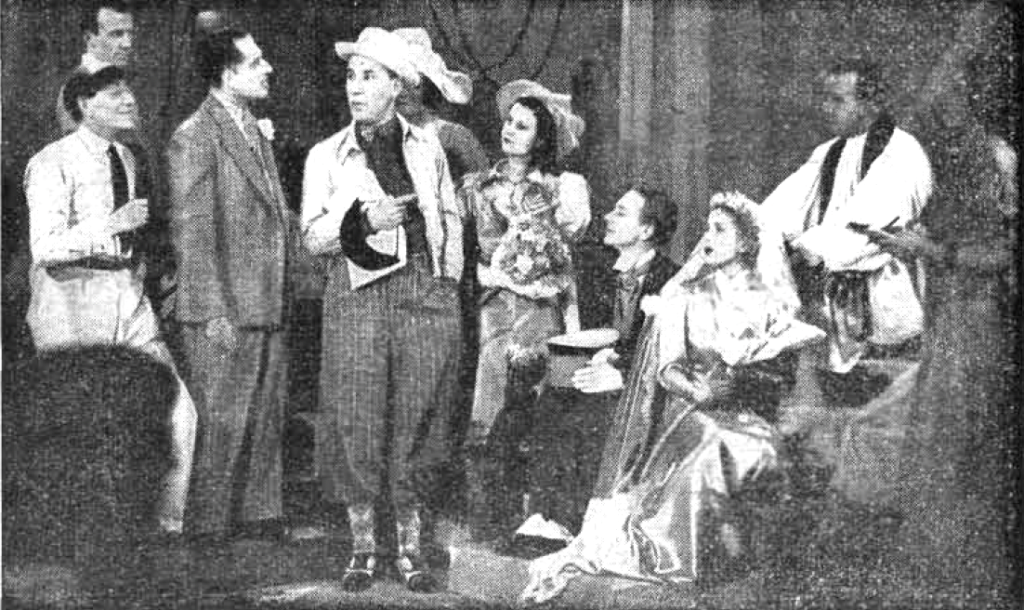OTD in early British television: 6 December 1937

John Wyver writes: The afternoon of 6 December 1937 saw the first presentation from Alexandra Palace of what became the most popular production among pre-war dramas. Once in a Lifetime by Moss Hart and George Kaufman, adapted for television by producer Eric Crozier (there’s a production shot above), was played six times, including this matinee, with its last outing in early 1939. A satire about Hollwood, which premiered in New York in 1930, and now given a year and a month after the start of the AP service, this was also the most ambitious television staging to date, and the first programme to run continuously for the hitherto unimaginable length of 90 minutes.
A preview in Television and Short-wave World outlined the plot:
Joan Miller, television’s Picture Page girl, who has already appeared in many dramatic productions at Alexandra Palace, will take the part of May, a member of an unsuccessful music hall trio, who “cashes in” on the sudden arrival of talking pictures by opening a school of elocution… George and Jerry, the companions, who accompany her to Los Angeles, are also caught up in the film machine, to meet with adventures which should make splendid entertainment on the television screen. The action is quick moving, and the scenes, ranging from a cheap lodging-house via Pullman cars to Los Angeles hotels and film studios, chase each other with a rapidity that will keep the television cameras busy. (‘Scannings and reflections’, December 1937)
‘The Scanner’ for Radio Times was similarly keen in their anticipation:
At the moment the most envied producer at Alexandra Palace is twenty-three-year-old Eric Crozier, the youngest producer in the television service. He has been entrusted with the production of Once in a Lifetime… and the timings you see for it in the programme columns are not misprints —the show really has been allocated ninety minutes.
As far as I can remember, no television producer has yet sat on duty in the control-room for as long as an hour and a half. If you saw the film [released in 1932, directed by Russell Mack]… or the stage production at the Queen’s Theatre, London, you won’t need my word to tell you that Once in a Lifetime is a very funny satire. From the production point of view, however, Once in a Lifetime won’t be so funny. The ‘sets’, five different ones, will be prepared and a preliminary rehearsal will be held on Sunday—the first time that such a thing has been found necessary at Alexandra Palace.
On Monday, the day of the first performance, there will be the customary morning rehearsal in the studio. Or, rather, studios, for the studio that has been out of operation and dismantled since one system of transmission was adopted will be used to house one scene. This will mean that at this point those taking part in the show will have to rush out of No. 1 studio and race down the corridor to take up their positions in No. 2 studio.
Studio B, or ‘No. 2’ studio, had been used mostly for rehearsals since the decommissioning of the Baird equipment at the end of January 1937. For Once in a Lifetime, two of the four Emitron cameras were moved there and cables run along the corridor to connect to the single operational control room.
‘The Scanner’ continued:
Another thing about Once in a Lifetime—one of the scenes is a ‘ set’ in a Hollywood film studio. Not very much will have to be done to the television studio to get this effect; put a ‘ blimp’ over an Emitron, and only an expert would know that it was not a film camera. On the screen you will see several of the studio staff doing their best to look like the staff of a film studio. (3 December 1937)
And comparisons with the cinema were echoed in the response from an anonymous Times critic:
The technique of the cinema… was freely drawn on for Once in a Lifetime, which was excellent entertainment from the first moment to the last… If television can be as good as this it will be a real rival to the films. (13 December 1937)
Audience reaction was such that the show was given five reprises: four days after the first presentation, on the evening of 6 December 1937, then on 1 January and 2 February 1938, on the afternoon of Boxing Day that year, and finally on 4 January 1939. Forty years on, Trevor Nunn’s RSC production, with astonishing designs by John Napier, which I saw at the Aldwych, remains one of my most precious theatre memories.
Leave a Reply